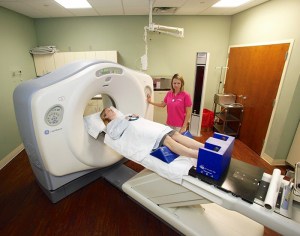There are several different types of radiation therapy. Radiation oncology, or radiation therapy, uses streams of high-energy particles or waves, such as x-rays or electrons to shrink tumors and destroy cancer cells. Roughly half of all cancer patients receive some type of radiation therapy at one point during the term of their treatment.
Steven G. Lester, M.D., FACRO, says questions about the types of radiation oncology are common among his patients. “Radiation has evolved from being cobalt-60 sources, which is a radioactive element in the head of a treatment machine, to now having high-energy linear accelerators,” he explains. “Proton beams are another form of radiation we employ.”
The most appropriate form of radiation therapy will depend on the type and size of the cancer tumor.
“A high energy linear accelerator usually has two options: X-rays or electrons,” Dr. Lester says. “Electrons are used for superficial tumors like skin cancers or early-stage breast cancer with tumors close to the surface, while X-rays are used for deeper structures.”
“Protons are a new form of radiation, and although they are still being studied, they may be beneficial for small brain tumors,” he continues. “The advantage to protons is that you can control the exit dose.”
Patients with cancer should consult with a radiation oncologist to determine what procedure is right for them. Dr. Lester stresses that it’s crucial for patients to understand that the volume radiation oncologists treat is based on the cancer.
“For example in a prostate (cancer), the rectum pushes up against the prostate and the prostate droops over the rectum,” says Dr. Lester. “Therefore, there is no beam available that won’t treat the front of the rectum at the same time you treat the prostate. When your physician recommends that you need a linear accelerator treatment versus getting referred to an institution that has an active scanning proton beam, the volume has been determined by the tumor, not by the beam.”
“At the Central Florida Care Center, we have IMRT and IGRT which is standard throughout the country,” says Dr. Lester. “We can treat 95% of all cancers that are referred to us, and 5% we refer out.”
What to Expect from Radiation Oncology
 When patients and their doctors decide to pursue radiation therapy for cancer treatment, they will likely undergo one of the following two types of radiation oncology treatment types:
When patients and their doctors decide to pursue radiation therapy for cancer treatment, they will likely undergo one of the following two types of radiation oncology treatment types:
External Beam Radiation Therapy. External beam radiation therapy can be used to treat many types of cancer. A linear accelerator administers direct radiation to the affected area. Each session lasts about 15 minutes and is painless. Patients typically have five treatment sessions each week with a consecutive two-day break to allow healthy tissue that may have been damaged to heal. This continues for about six weeks.
Internal Radiation Therapy. This treatment, also known as brachytherapy or seed treatment, involves temporary or permanent placement of radioactive sources in the tumor site. Internal radiation therapy is commonly employed to treat head and neck, breast, cervix, prostate and eye cancer. The procedure allows the doctor to administer a higher total dose of radiation to a smaller area in a single procedure. This treatment can be used alone or combined with external beam radiation.
In some cases, radiation therapy can be used in conjunction with surgery, chemotherapy or both. The optimal treatment plan will depend on the type of cancer and how advanced it is.
“We’ll be happy to talk to you about your treatment plan and what would be best for you,” says Dr. Lester.

